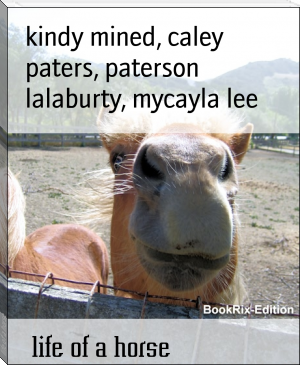Wild Beasts and Their Ways by Sir Samuel White Baker (adult books to read txt) 📕

- Author: Sir Samuel White Baker
Book online «Wild Beasts and Their Ways by Sir Samuel White Baker (adult books to read txt) 📕». Author Sir Samuel White Baker
it lies, and at once retreat to water, instead of concealing the prey and lying down in the vicinity. In such a case the remains of the body will be exposed to the gaze of vultures and jackals, who will pick the bones clean in a few hours, and destroy all chance of the tiger's return. When the dead body is concealed beneath dense bushes in a deep ravine, the vultures cannot discover it, as they hunt by sight, and the tiger has no anxiety respecting the security of its capture; it will therefore sleep in peace within a short distance, until awakened by the shouts of a line of beaters.
If the buffalo is tied with a rope around the neck, a tiger will frequently refuse to molest it, as it fears a trap. I have seen occasions when the tiger has walked round and round the buffalo, as exhibited by the tracks upon the surface, but it has been afraid to make its spring, being apprehensive of some hidden danger. I have also seen a dead vulture lying close to the body of a buffalo, evidently killed by a blow from the tiger's paw when trespassing upon the feast. It is a good arrangement to secure both fetlocks of a buffalo with a piece of strong cord about a foot or 16 inches apart, independently of the weaker cord which ties the animal to either a stake or tree. Should the buffalo break away during the night, it cannot wander far, as the bushes will quickly anchor the rope which confines the fore legs; the tiger would then assuredly attack the straying animal and kill it within the jungles. In such a case the drive should take place without delay, as the dead buffalo will certainly be hidden in the nearest convenient spot, and the tiger will be somewhere in the neighbourhood.
During the hot season it will be advisable to defer the drive till about IO A.M., at which time the tiger will be asleep. The mucharns or watching-places in various trees should have been previously constructed before the buffaloes were tied up in their different positions, to be ready should the tiger kill one of the baits, and thus to avoid noise during the construction. This is a matter of very great importance which is frequently neglected by the native shikari, who postpones the building of mucharns until the tiger shall have killed a buffalo. In that case the noise of axes employed in chopping the wood necessary for building the platforms is almost sure to alarm the tiger, who will escape unseen, and the beat will take place in vain.
I never allow mucharns to be built by wood felled in the immediate neighbourhood, but I have it prepared in camp, and transported by coolies to the localities when required. By this method the greatest silence may be observed, which is absolutely necessary to ensure a successful drive.
In order to prepare these platforms, they should be laid upon the ground, three long thick pieces to form a triangle, and cross-bars in proportionate lengths. If the latter are straight and strong, from sixteen to twenty will be necessary to complete a strong mucharn. It is impossible to devote too much attention to the construction of these watching-places. The natives are so light, and they are so comfortable when squatting for hours in a position that would cramp a European, that it is dangerous to accept the shikari's declaration when he reports that everything is properly arranged. Upon many occasions tigers are missed because the shooter is so completely cramped that he cannot turn when the animal suddenly appears in view. A large, firm, and roomy mucharn fixed upon the boughs of a tree that will not wave before a gust of wind, is the proper platform to ensure a successful shot.
I have frequently been perched in a mere heron's nest, formed of light wood arranged upon most fragile boughs; this wretched contrivance has swayed before the wind to an extent that would have rendered accurate aim impossible; fortunately upon such occasions I have never obtained a shot.
Although driving may read as an unexciting sport, it is quite the contrary if the hunter takes sufficient interest in the operations to attend to every detail personally. When all is in readiness after the tiger has killed a buffalo, there is much art required in the conduct of the drive. Natives vary in different districts; some are clever and intelligent, and take an immense interest in the sport, especially if they are confident in the generosity of their employer. In other districts there may be abundant game, but the natives are cowardly, and nothing will persuade them to keep an unbroken line, upon the perfection of which the success of the drive depends.
As a rule, there is no great danger in the steady advance of a line of men, provided they are at close intervals of 5 or 8 yards apart, and that they keep this line intact. It is a common trick, when the beaters are nervous, to open out the line in gaps, and the men resolve themselves into parties of ten or twenty, advancing in knots, at the same time howling and shouting their loudest to keep up the appearance of a perfect line. In such cases the tiger is certain to break back through one of the inviting gaps, and the drive is wasted.
To drive successfully, the beaters must not only keep a rigid line, but they must thoroughly understand the habits of the animal, and the positions of the posted guns. If the drive is thoroughly well organised, there should be eight or ten men who are experienced in the sport; these should take the management of the beat, and being distributed at intervals along the line, they should direct the operations.
A few really clever shikaris should be able (with few exceptions to the rule) to drive the tiger to any required position, so as to bring it within shot of any particular mucharn. This may be effected without extraordinary difficulty. The drive should be arranged to include three parts of a circle. If there are three guns, their positions would depend upon the quality and conditions of the ground, leaving intervals of only 80 or 100 yards at farthest between the three mucharns. From either flank, commencing only 50 yards from each mucharn, a native should be posted in a tree, and this system of watchers should be continued until they meet the extreme ends of the right and left flanks of the beating line. It will be seen that by this method there is a chain of communication established throughout the line, both flanks being in touch with the right and left mucharns by watchers in the trees only 50 yards apart. The tiger, if within the beat, will be completely encircled, as it will have the guns in front, the line of beaters in a semicircle behind, and a chain of watchers in trees from 30 to 50 yards apart from either side of the line to within sight of the mucharns. If the jungle should be tolerably open, the tiger cannot move without being seen by somebody. It now has to be driven before the beaters, and it should be induced to select a particular direction that will bring it within distance of one particular mucharn.
Each man who may be perched in the trees, which form a chain from the right and left extremities of the line, will be provided with several pieces of exceedingly dry and brittle sticks; he will hold these in readiness for use whenever he may observe the tiger. If he sees that the animal wishes to pass through the line, and thereby escape from the beat, he simply breaks a small stick in half; the sound of a snap is quite sufficient to divert the tiger from its course; it will generally stop and listen for a few moments, and then being alarmed by the unusual sound, it will again move forward, this time in the required direction, towards the guns. In this manner the animal is gradually guided by the unseen watchers in the trees, and is kept under due control, without any suspicion upon its part that it is being conducted to the fatal spot within 30 or 40 yards of the deadly aim of an experienced rifle. This leading of the tiger requires considerable skill, as much discretion is necessary in breaking the stick at the proper moment, or increasing the noise should it be deemed expedient.
As a rule, the slightest sound is sufficient to attract the attention of a driven tiger, as the animal is well aware that the shouts of a line of beaters are intended to scare it from the neighbourhood; it is accordingly in high excitement, and it advances like a sly fox slowly and cautiously, occasionally stopping, and turning its head to listen to the cries of the approaching enemy. Any loud and sudden noise would induce it to turn and charge back towards the rear, in which case it is almost certain to escape from the beat.
Some tigers are more clever than others, and having escaped upon more than one occasion, they will repeat the dodge that has hitherto succeeded. It is a common trick, should the jungle be dense and the ground much broken, for the tiger to crouch when it hears the beaters in the distance, instead of going forward in the direction of the guns. This is a dangerous stratagem, as the wary animal will lie quietly listening to the approaching line, and having waited until the beaters are within a few yards of its unexpected lair, it will charge back suddenly with a terrific roar, and dash at great speed through the affrighted men, perhaps seizing some unfortunate who may be directly in its path. I have known tigers that have been hunted many times, but who have always escaped by this peculiar dodge, and such animals are exceedingly difficult to kill. In such cases I am of opinion that no shouts or yells should be permitted, but that the line should advance, simply beating the stems of trees with their sticks; at the same time six or eight natives with their matchlocks should be placed at intervals along the line to fire at the tiger should it attempt to break through the rear. This may sometimes, but rarely, succeed in turning it, and compelling it to move in the required direction. It is a curious fact that "breaking back" is a movement general to all animals, which have an instinctive presentiment of danger in the front, if alarmed by the sound of beaters from behind. If once they determine upon a stampede to the rear, nothing will stop them, but they will rush to destruction and face any opposition rather than move forward before the line. The tiger in such cases is extremely dangerous, although when retreating in an ordinary manner before the beaters it would seldom attack a human being, but, on the contrary it would endeavour to avoid him. It is frequently the custom of tigers to remain together in a family the male, female, and a couple of half or three parts grown young ones. We cannot positively determine whether the male always remains with his family under such circumstances, or whether he merely visits them periodically; I am inclined to the latter opinion, as I think the female may be attractive during her season, which induces the male to prolong his visit, although at other periods he may be leading an independent life. Good fortune specially attends some favoured sportsmen who have experienced the intensity of happiness when a complete family of tigers has marched past their position in a drive, and they have bagged every
If the buffalo is tied with a rope around the neck, a tiger will frequently refuse to molest it, as it fears a trap. I have seen occasions when the tiger has walked round and round the buffalo, as exhibited by the tracks upon the surface, but it has been afraid to make its spring, being apprehensive of some hidden danger. I have also seen a dead vulture lying close to the body of a buffalo, evidently killed by a blow from the tiger's paw when trespassing upon the feast. It is a good arrangement to secure both fetlocks of a buffalo with a piece of strong cord about a foot or 16 inches apart, independently of the weaker cord which ties the animal to either a stake or tree. Should the buffalo break away during the night, it cannot wander far, as the bushes will quickly anchor the rope which confines the fore legs; the tiger would then assuredly attack the straying animal and kill it within the jungles. In such a case the drive should take place without delay, as the dead buffalo will certainly be hidden in the nearest convenient spot, and the tiger will be somewhere in the neighbourhood.
During the hot season it will be advisable to defer the drive till about IO A.M., at which time the tiger will be asleep. The mucharns or watching-places in various trees should have been previously constructed before the buffaloes were tied up in their different positions, to be ready should the tiger kill one of the baits, and thus to avoid noise during the construction. This is a matter of very great importance which is frequently neglected by the native shikari, who postpones the building of mucharns until the tiger shall have killed a buffalo. In that case the noise of axes employed in chopping the wood necessary for building the platforms is almost sure to alarm the tiger, who will escape unseen, and the beat will take place in vain.
I never allow mucharns to be built by wood felled in the immediate neighbourhood, but I have it prepared in camp, and transported by coolies to the localities when required. By this method the greatest silence may be observed, which is absolutely necessary to ensure a successful drive.
In order to prepare these platforms, they should be laid upon the ground, three long thick pieces to form a triangle, and cross-bars in proportionate lengths. If the latter are straight and strong, from sixteen to twenty will be necessary to complete a strong mucharn. It is impossible to devote too much attention to the construction of these watching-places. The natives are so light, and they are so comfortable when squatting for hours in a position that would cramp a European, that it is dangerous to accept the shikari's declaration when he reports that everything is properly arranged. Upon many occasions tigers are missed because the shooter is so completely cramped that he cannot turn when the animal suddenly appears in view. A large, firm, and roomy mucharn fixed upon the boughs of a tree that will not wave before a gust of wind, is the proper platform to ensure a successful shot.
I have frequently been perched in a mere heron's nest, formed of light wood arranged upon most fragile boughs; this wretched contrivance has swayed before the wind to an extent that would have rendered accurate aim impossible; fortunately upon such occasions I have never obtained a shot.
Although driving may read as an unexciting sport, it is quite the contrary if the hunter takes sufficient interest in the operations to attend to every detail personally. When all is in readiness after the tiger has killed a buffalo, there is much art required in the conduct of the drive. Natives vary in different districts; some are clever and intelligent, and take an immense interest in the sport, especially if they are confident in the generosity of their employer. In other districts there may be abundant game, but the natives are cowardly, and nothing will persuade them to keep an unbroken line, upon the perfection of which the success of the drive depends.
As a rule, there is no great danger in the steady advance of a line of men, provided they are at close intervals of 5 or 8 yards apart, and that they keep this line intact. It is a common trick, when the beaters are nervous, to open out the line in gaps, and the men resolve themselves into parties of ten or twenty, advancing in knots, at the same time howling and shouting their loudest to keep up the appearance of a perfect line. In such cases the tiger is certain to break back through one of the inviting gaps, and the drive is wasted.
To drive successfully, the beaters must not only keep a rigid line, but they must thoroughly understand the habits of the animal, and the positions of the posted guns. If the drive is thoroughly well organised, there should be eight or ten men who are experienced in the sport; these should take the management of the beat, and being distributed at intervals along the line, they should direct the operations.
A few really clever shikaris should be able (with few exceptions to the rule) to drive the tiger to any required position, so as to bring it within shot of any particular mucharn. This may be effected without extraordinary difficulty. The drive should be arranged to include three parts of a circle. If there are three guns, their positions would depend upon the quality and conditions of the ground, leaving intervals of only 80 or 100 yards at farthest between the three mucharns. From either flank, commencing only 50 yards from each mucharn, a native should be posted in a tree, and this system of watchers should be continued until they meet the extreme ends of the right and left flanks of the beating line. It will be seen that by this method there is a chain of communication established throughout the line, both flanks being in touch with the right and left mucharns by watchers in the trees only 50 yards apart. The tiger, if within the beat, will be completely encircled, as it will have the guns in front, the line of beaters in a semicircle behind, and a chain of watchers in trees from 30 to 50 yards apart from either side of the line to within sight of the mucharns. If the jungle should be tolerably open, the tiger cannot move without being seen by somebody. It now has to be driven before the beaters, and it should be induced to select a particular direction that will bring it within distance of one particular mucharn.
Each man who may be perched in the trees, which form a chain from the right and left extremities of the line, will be provided with several pieces of exceedingly dry and brittle sticks; he will hold these in readiness for use whenever he may observe the tiger. If he sees that the animal wishes to pass through the line, and thereby escape from the beat, he simply breaks a small stick in half; the sound of a snap is quite sufficient to divert the tiger from its course; it will generally stop and listen for a few moments, and then being alarmed by the unusual sound, it will again move forward, this time in the required direction, towards the guns. In this manner the animal is gradually guided by the unseen watchers in the trees, and is kept under due control, without any suspicion upon its part that it is being conducted to the fatal spot within 30 or 40 yards of the deadly aim of an experienced rifle. This leading of the tiger requires considerable skill, as much discretion is necessary in breaking the stick at the proper moment, or increasing the noise should it be deemed expedient.
As a rule, the slightest sound is sufficient to attract the attention of a driven tiger, as the animal is well aware that the shouts of a line of beaters are intended to scare it from the neighbourhood; it is accordingly in high excitement, and it advances like a sly fox slowly and cautiously, occasionally stopping, and turning its head to listen to the cries of the approaching enemy. Any loud and sudden noise would induce it to turn and charge back towards the rear, in which case it is almost certain to escape from the beat.
Some tigers are more clever than others, and having escaped upon more than one occasion, they will repeat the dodge that has hitherto succeeded. It is a common trick, should the jungle be dense and the ground much broken, for the tiger to crouch when it hears the beaters in the distance, instead of going forward in the direction of the guns. This is a dangerous stratagem, as the wary animal will lie quietly listening to the approaching line, and having waited until the beaters are within a few yards of its unexpected lair, it will charge back suddenly with a terrific roar, and dash at great speed through the affrighted men, perhaps seizing some unfortunate who may be directly in its path. I have known tigers that have been hunted many times, but who have always escaped by this peculiar dodge, and such animals are exceedingly difficult to kill. In such cases I am of opinion that no shouts or yells should be permitted, but that the line should advance, simply beating the stems of trees with their sticks; at the same time six or eight natives with their matchlocks should be placed at intervals along the line to fire at the tiger should it attempt to break through the rear. This may sometimes, but rarely, succeed in turning it, and compelling it to move in the required direction. It is a curious fact that "breaking back" is a movement general to all animals, which have an instinctive presentiment of danger in the front, if alarmed by the sound of beaters from behind. If once they determine upon a stampede to the rear, nothing will stop them, but they will rush to destruction and face any opposition rather than move forward before the line. The tiger in such cases is extremely dangerous, although when retreating in an ordinary manner before the beaters it would seldom attack a human being, but, on the contrary it would endeavour to avoid him. It is frequently the custom of tigers to remain together in a family the male, female, and a couple of half or three parts grown young ones. We cannot positively determine whether the male always remains with his family under such circumstances, or whether he merely visits them periodically; I am inclined to the latter opinion, as I think the female may be attractive during her season, which induces the male to prolong his visit, although at other periods he may be leading an independent life. Good fortune specially attends some favoured sportsmen who have experienced the intensity of happiness when a complete family of tigers has marched past their position in a drive, and they have bagged every
Free e-book «Wild Beasts and Their Ways by Sir Samuel White Baker (adult books to read txt) 📕» - read online now
Similar e-books:





Comments (0)